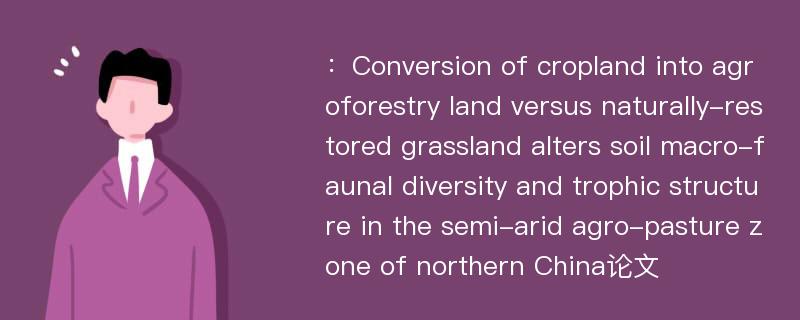
本文主要研究内容
作者(2019)在《Conversion of cropland into agroforestry land versus naturally-restored grassland alters soil macro-faunal diversity and trophic structure in the semi-arid agro-pasture zone of northern China》一文中研究指出:Restoration of cropland(termed ’Farm’) after abandonment including shrubs(termed ’Shrub’),trees(termed ’Tree’) and natural grassland(termed ’Grass’) has become a routine process aimed to improve land productivity and control desertification. During this restoration process, soil macro-faunal diversity, and trophic structure were investigated at four types of sites(Farm, Shrub, Tree, and Grass)during growing season in the semi-arid agro-pasture zone of northern China. Results indicated that the Staphylinidae family was found to dominate at the Grass, Shrub, and Tree sites, whiles larval Pyralidae individuals were found at the Grass site only. The density of the omnivores(i.e., Formicidae family) was significantly(P<0.05) greater at the Grass site than at the Tree and Farm sites. The total density and richness of predator and phytophages were found to be markedly(P<0.05) greater at the Grass site than at the Farm site. Meanwhile, we found the taxon richness of predators was significantly(P<0.05) higher at the Shrub site than at the Farm and Tree sites. Compared with the Farm and afforested Shrub/Tree sites,the Grass site had greater density, taxon richness, and Shannon index(P<0.05). In conclusion, natural restoration of abandoned croplands toward grassland was an effective strategy relative to artificial afforestation for improvement of soil biological diversity. Moreover, planting shrub is a preferable measure in abandoned croplands for land development in the semi-arid agro-pasture zone of northern China.
Abstract
Restoration of cropland(termed ’Farm’) after abandonment including shrubs(termed ’Shrub’),trees(termed ’Tree’) and natural grassland(termed ’Grass’) has become a routine process aimed to improve land productivity and control desertification. During this restoration process, soil macro-faunal diversity, and trophic structure were investigated at four types of sites(Farm, Shrub, Tree, and Grass)during growing season in the semi-arid agro-pasture zone of northern China. Results indicated that the Staphylinidae family was found to dominate at the Grass, Shrub, and Tree sites, whiles larval Pyralidae individuals were found at the Grass site only. The density of the omnivores(i.e., Formicidae family) was significantly(P<0.05) greater at the Grass site than at the Tree and Farm sites. The total density and richness of predator and phytophages were found to be markedly(P<0.05) greater at the Grass site than at the Farm site. Meanwhile, we found the taxon richness of predators was significantly(P<0.05) higher at the Shrub site than at the Farm and Tree sites. Compared with the Farm and afforested Shrub/Tree sites,the Grass site had greater density, taxon richness, and Shannon index(P<0.05). In conclusion, natural restoration of abandoned croplands toward grassland was an effective strategy relative to artificial afforestation for improvement of soil biological diversity. Moreover, planting shrub is a preferable measure in abandoned croplands for land development in the semi-arid agro-pasture zone of northern China.
论文参考文献
论文详细介绍
论文作者分别是来自Journal of Arid Land的,发表于刊物Journal of Arid Land2019年02期论文,是一篇关于,Journal of Arid Land2019年02期论文的文章。本文可供学术参考使用,各位学者可以免费参考阅读下载,文章观点不代表本站观点,资料来自Journal of Arid Land2019年02期论文网站,若本站收录的文献无意侵犯了您的著作版权,请联系我们删除。
